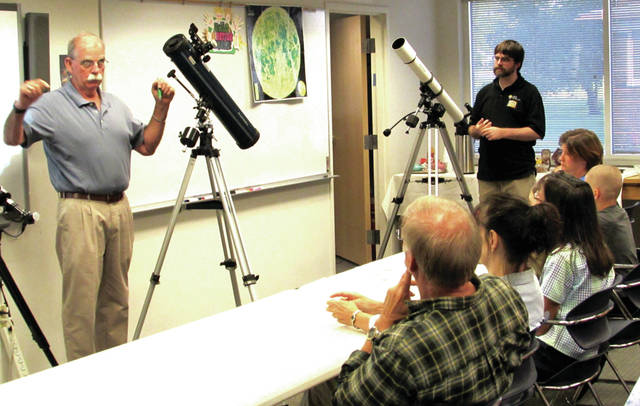
BRADFORD — Folks were treated to a workshop in astronomy during “Glancing at the Stars,” at Bradford Public Library Tuesday.
The timing of the workshop was to celebrate the 48th anniversary of the first moon landing. It was presented by the “father-son” duo Paul and Eric Sullenberger, from Piqua, to a packed house. Eric is a teacher at Russia Local Schools and both he and Paul are avid astronomers. The program was packed full of information about the study of astronomy, including: the science of astrology, naked – eye astronomy; the use of magnified viewing; cell-phone apps; looking at the galaxy and what lies beyond. Paul started the presentation with a poem by Walt Whitman, “When I Heard the Learn’d Astronomer”.
“When I heard the learn’d astronomer; when the proofs, the figures, were ranged in columns before me; when I was shown the charts and diagrams, to add, divide, and measure them; when I sitting heard the astronomer, where he lectured with much applause in the lecture-room; how soon unaccountable I became tired and sick; till rising and gliding out I wander’d off by myself, in the mystical moist night-air; and from time to time, look’d up in perfect silence at the stars.”
Eric said he had to disagree with Whitman, that while star-gazing is beautiful, knowledge does not take away from the beauty. As it happened, Paul was probably about five-years-old when his mother drew a picture of the Big Dipper on a piece of paper.
“She told me to look in the sky and find something that looks like that,” he said. “About 30 years later, I did the same thing to Eric and that is what sparked his interest and why he is a science teacher today.”
Both Paul and Eric took turns discussing the high points of astronomy with a conversation about the Aug. 21 total solar eclipse. People across the United States will see the “Great American Total Solar Eclipse” from Oregon to South Carolina, along a stretch of land about 70 miles (113 kilometers) wide, when the skies will darken, turning daylight into twilight, causing the temperature to drop rapidly. Eric said he was traveling to St. Louis with his family to watch it. Paul said the eclipse will be visible in Ohio, but the sun will only be blocked about 85 percent.
“To view it, you have to protect your eyes,” he said.
Another lesson was about purchasing microscopes and binoculars. Out of the two different types of microscopes, he recommended is the reflector type. But, most people are born with everything they need to watch sky, he said.
“The most important piece of astronomy equipment are your eyes,” he said. “Telescopes have only been around a little more than 400 years. Astronomical observation goes back 20,000. There are markings in a cave in France of stars and planets from 18,000 B.C.”
His advice continued when watching the upcoming Perseid Meteor Shower. It peaks August 12.
“You don’t need binoculars,” he said. “In fact, you won’t see as many if you look through binoculars. You won’t need a telescope. All you need is to sit out in a dark area with a comfortable chair and look up. You will see them. “
Eric added for naked – eye astronomy to get oriented ahead of time of north, south, east and west. He explained that because the earth has a tilted axis it causes the four seasons. Because of the tilt, some constellations are always up in the night sky, such as the northern circumpolar, which include: Auriga, Camelopardalis, Cassiopeia, Cepheus,Draco, Lynx, Perseus, Ursa Major, and Ursa Minor. These constellations are always visible in the night sky of the Northern Hemisphere.
“The north circumpolar constellations are ideal for guiding you to see many things out there,” Eric said. “The easiest most obvious one is the Big Dipper. It is actually an acsterism meaning an unofficial constellation. It is technically a smaller part of a larger constellation. We here in the states have gone with the Indian tradition of a dipper. It is fairly obvious and always in the northern sky. If you can find the big dipper, you can navigate yourself to the other north circumpolar constellations always out and visible in the night sky, and to guide you towards other things.”
To find out more about the total eclipse, visit www.space.com/33797-total-solar-eclipse-2017-guide.html


